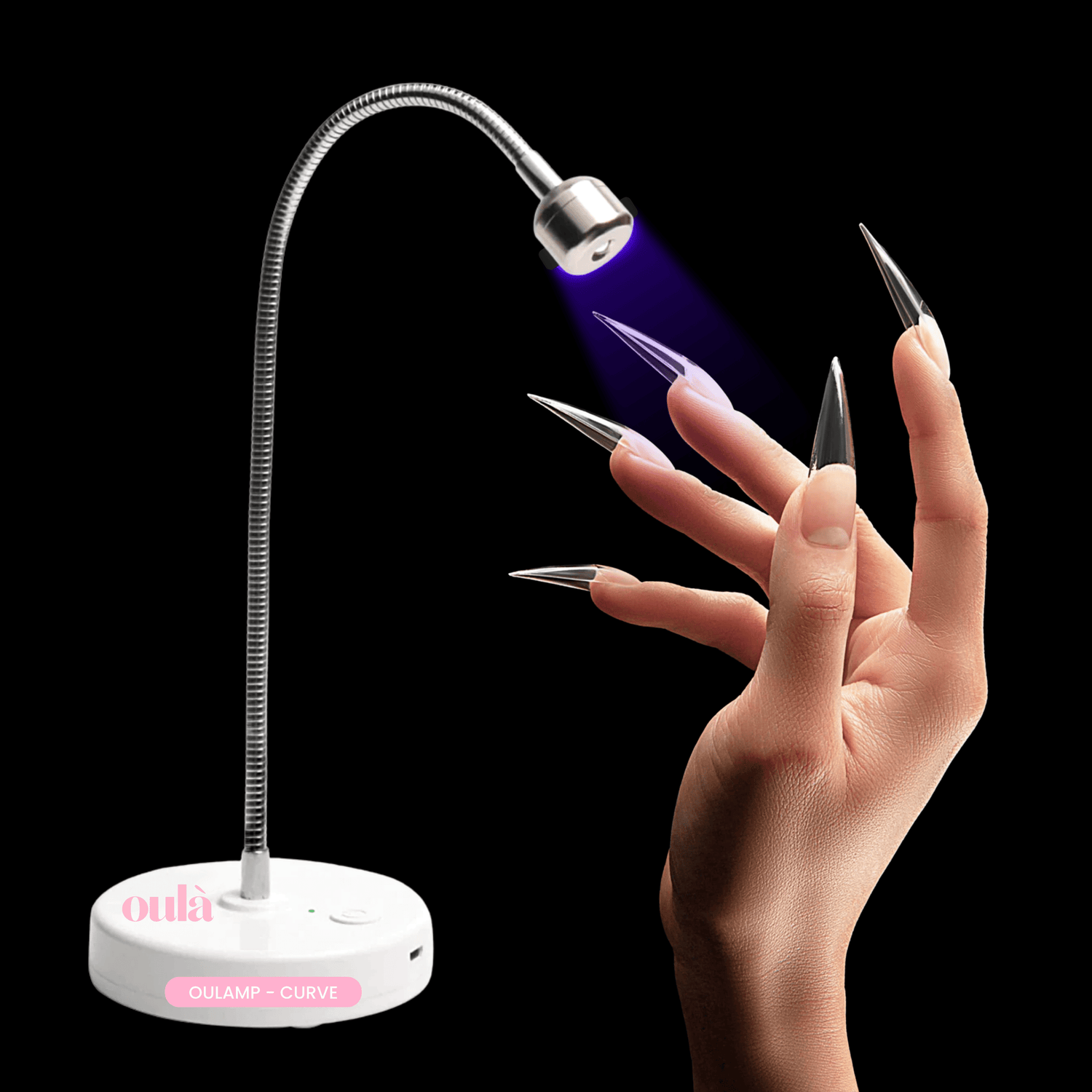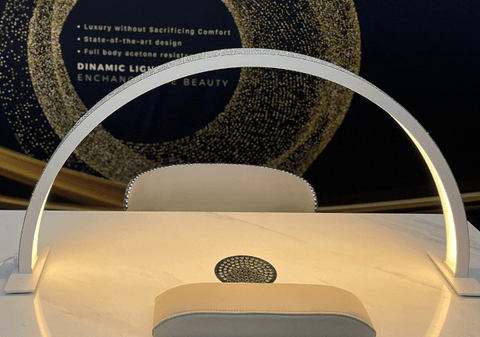Are you wondering if you can cure your gel nails using a desk lamp? If you’ve ever tried drying your gel polish at home, you know how tricky it can be to get that perfect, long-lasting finish.
Using the right light is key, but can a simple desk lamp really do the job? Keep reading to find out the truth behind curing gel nails with a desk lamp—and discover the easy tips that will save your manicure from smudges and chips.
Your nails deserve the best, and you’re just one step away from learning how to achieve salon-quality results at home.
How Gel Nails Cure
Understanding how gel nails cure is essential if you want flawless results. Gel polish doesn’t dry like regular nail polish—it hardens through a chemical reaction activated by specific light waves. This process ensures your nails stay shiny and chip-free for weeks.
Role Of Uv And Led Light
UV and LED lights emit ultraviolet rays that trigger a photochemical reaction in the gel polish. This reaction causes the gel to harden or “cure” quickly. Without this light, gel polish remains sticky and won’t set properly.
UV lamps have been used longer and cure polish across all gel formulas. LED lamps work faster but only cure gel polishes designed for LED light. Both types create a strong, durable finish that regular air drying can’t achieve.
Differences Between Desk Lamps And Nail Lamps
Desk lamps look similar to nail lamps but don’t emit the specific UV or LED light needed to cure gel nails. They provide visible light, which won’t harden the polish. Using a desk lamp alone will leave your gel polish wet and prone to smudging.
Some people try curing gel nails under a desk lamp, hoping it will work. However, without the right wavelength and intensity, the gel stays tacky. Nail lamps are specially designed with bulbs that emit the exact light frequency needed for curing.
Have you ever tried using a regular lamp for gel nails? Chances are you noticed the polish stayed sticky or peeled off quickly. That’s because the desk lamp can’t replace the curing power of a UV or LED nail lamp.
Types Of Desk Lamps
Desk lamps come in many types and styles. Each type uses different bulbs and light settings. Choosing the right desk lamp matters for curing gel nails. Some lamps do not produce the right kind of light needed for gel polish to harden. Understanding the types of desk lamps helps decide if one can cure gel nails effectively.
Common Desk Lamp Bulbs
Desk lamps usually use these bulb types:
- Incandescent bulbs: These give warm light but low UV output.
- Fluorescent bulbs: They are bright but lack the correct wavelength for gel nails.
- LED bulbs: Common in modern lamps, they use less energy and last longer.
Most gel nail curing requires UV or LED light bulbs. Regular bulbs do not cure gel properly.
Light Wavelengths And Intensity
Gel nails need light in a specific wavelength range to cure. UV light usually ranges from 320 to 400 nanometers. LED lamps used for nails emit light in a narrow band around 365 or 405 nanometers.
Intensity matters too. Too weak light will not harden the gel. Desk lamps often lack the power needed. Nail curing lamps are designed with stronger light intensity to cure quickly.
Effectiveness Of Desk Lamps For Gel Nails
When it comes to drying gel nails, many wonder if a desk lamp can do the trick. The idea might sound convenient, especially if you don’t have a dedicated UV or LED nail lamp. But how effective is a desk lamp for curing gel nails? Let’s explore this by considering the curing time, potential risks, and limitations involved.
Curing Time Comparison
Typically, UV or LED lamps designed for nails cure gel polish in a matter of minutes. Desk lamps, however, lack the specific light spectrum necessary to efficiently cure gel nails. You might find yourself waiting much longer, only to end up with nails that aren’t fully set.
Imagine painting your nails with the perfect color, only to have them smudge as soon as you touch something. It’s frustrating! A dedicated nail lamp can save you from this hassle by providing even and quick curing. Are you willing to risk more time for potentially less effective results?
Potential Risks And Limitations
Using a desk lamp for curing gel nails isn’t just about time; it’s about safety too. Desk lamps are not designed to emit the UV or LED light needed to cure gel polish effectively. This means your nails may remain tacky, leading to smudges and premature chipping.
Additionally, prolonged exposure to unsuitable light might even cause skin irritation. Your hands are delicate, and they deserve the right treatment. Wouldn’t you rather invest in a tool that ensures both beauty and safety?
In the world of nail care, shortcuts can sometimes lead to more trouble than they’re worth. While a desk lamp might seem like a clever hack, it might just leave you with unfinished nails and a lot of wasted time.

Credit: www.amazon.com
Expert Tips For Safe Gel Nail Curing
Getting your gel nails perfectly cured at home requires more than just slapping on some polish and waving your hand under any light. Safe gel nail curing depends on using the right tools and techniques to avoid skin damage and ensure your manicure lasts. Let’s dive into expert tips that can help you achieve a salon-quality finish while protecting your skin and nails.
Proper Lamp Selection
Not all desk lamps are created equal when it comes to curing gel nails. You need a lamp specifically designed for gel curing, typically UV or LED lamps, because regular desk lamps don’t emit the right type or intensity of light.
LED lamps are faster and safer—they cure polish in 30-60 seconds and produce less heat. UV lamps take longer (about 2 minutes) but work for all gel polish types. Choose a lamp with a timer and proper wattage (usually 24 to 48 watts) to avoid under or over-curing.
Have you checked the lamp’s wavelength range? The ideal curing light should emit UV light between 365-405 nm. Without the right wavelength, your gel polish won’t harden properly, leaving your nails sticky and prone to chipping.
Curing Techniques At Home
Once you have the right lamp, technique matters. Keep your hand steady and positioned close to the lamp’s light source. Moving your fingers during curing can cause uneven hardening and bubbles.
Here’s a checklist to follow:
- Apply thin layers of gel polish to ensure even curing.
- Hold your hand under the lamp for the full recommended curing time—don’t rush it.
- Avoid stacking thick coats as they may not cure thoroughly, leading to peeling.
- Use a curing lamp with a built-in timer to avoid under or overexposure.
I once tried curing gel nails under a regular desk lamp and ended up with sticky, smudged polish that ruined my manicure. After switching to a proper LED lamp and following the timing instructions, my nails looked flawless and lasted weeks. This experience proves that the right lamp and technique really make a difference.
Are you ready to upgrade your setup and nail your gel curing process safely? Your nails will thank you!
Alternatives To Desk Lamps
Using a desk lamp to cure gel nails might seem like a quick fix, but it often falls short. Luckily, there are better options to ensure your gel polish dries properly and lasts longer. Let’s look at some practical alternatives that can give you salon-quality results at home.
Professional Nail Lamps
Professional nail lamps are designed specifically for curing gel nails. They use either LED or UV light to harden the gel quickly and evenly.
If you’ve ever struggled with sticky or smudged nails after using a desk lamp, you’ll appreciate the consistent power of a professional lamp. These devices often come with timers and multiple light settings, so you can customize the curing process based on your gel brand.
Investing in a nail lamp means saving time and avoiding the frustration of redoing your manicure. Many models are compact and affordable, making them a smart addition to your nail care kit.
Natural Drying Methods
If you prefer to avoid gadgets, natural drying methods offer a slower but gentle alternative. Air drying your gel nails without a lamp takes patience, but it reduces exposure to UV light.
- Apply thin layers of gel polish to speed up drying time.
- Use a quick-dry topcoat designed for gel nails.
- Try dipping your nails in cold water after application to help set the polish.
Keep in mind, natural drying won’t give the same durability as curing with a lamp. But if you’re not in a rush, it’s an option worth trying. Have you ever left your nails to dry naturally and noticed any differences in how long they lasted?

Credit: www.jessicanailsupply.ca
Troubleshooting Gel Nail Issues
Troubleshooting gel nail issues can save you time, money, and frustration. If your gel nails don’t look or feel right after curing, understanding common problems helps you fix them quickly. Have you ever wondered why your nails feel soft or sticky even after using a lamp?
Signs Of Incomplete Curing
Incomplete curing is a common problem that can ruin your gel manicure. Look for these signs:
- Sticky or tacky surface:Your nails might feel sticky to the touch, which means the gel hasn’t hardened fully.
- Softness or flexibility:If the nails bend easily or feel squishy, they are not fully cured.
- Uneven shine:A dull or patchy shine often indicates partial curing.
Noticing these signs early helps prevent damage. Have you checked if your desk lamp emits the right UV or LED light for your gel polish?
Fixing Soft Or Sticky Nails
If your nails are soft or sticky, don’t panic. You can often fix this without removing the gel completely.
- Re-cure under the correct lamp:Use a lamp designed for gel nails, ideally a UV or LED lamp with the right wavelength. Desk lamps usually don’t provide enough curing power.
- Clean the sticky layer:Use a lint-free wipe soaked in isopropyl alcohol to remove the tacky residue after curing.
- Apply thin layers:Thick layers of gel take longer to cure and may remain sticky. Next time, apply thinner coats and cure each layer properly.
Have you tried curing your gel nails with a desk lamp? Chances are it won’t fully cure the gel because most desk lamps lack the specific light needed. Investing in a proper gel nail lamp makes a big difference in your manicure’s durability and finish.

Credit: www.luxspashop.com
Frequently Asked Questions
Can I Cure Gel Nails Using A Regular Desk Lamp?
No, regular desk lamps lack the specific UV or LED light needed to cure gel nails effectively. Using them will not harden the gel properly.
What Type Of Lamp Is Required To Cure Gel Nails?
Gel nails need either a UV or LED nail lamp. These lamps emit specific light wavelengths that cure the gel polish correctly.
How Long Does It Take To Cure Gel Nails Under A Uv Lamp?
Typically, curing gel nails under a UV lamp takes 2 to 3 minutes per layer. LED lamps usually cure faster.
Can Using The Wrong Lamp Damage Gel Nails?
Yes, improper curing with the wrong lamp can cause gel polish to peel, smudge, or remain sticky, reducing durability.
Conclusion
A desk lamp cannot properly cure gel nails. Gel nails need special UV or LED light. Using the wrong light may cause the polish to stay wet. This can lead to smudges or peeling. For best results, use a lamp made for gel nails.
Taking care with your tools helps nails look great longer. Remember, curing gel nails requires the right kind of light. Choose wisely to keep your nails strong and shiny.





